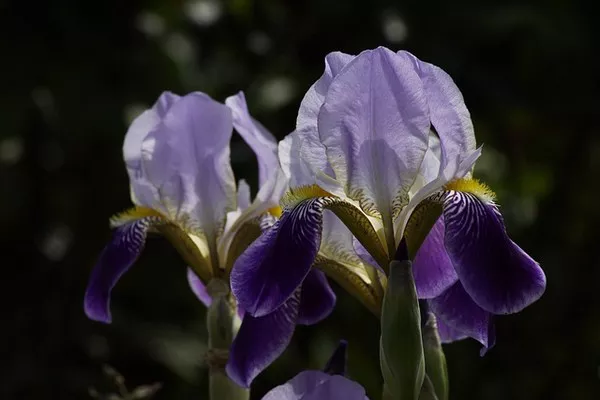Iris flowers, with their vibrant colors and intricate patterns, are a favorite among gardeners and floral enthusiasts alike. Named after the Greek goddess Iris, who personified the rainbow, these flowers come in a stunning array of hues, ranging from deep purples and blues to bright yellows and whites. Not only are they prized for their beauty, but irises also hold cultural significance, symbolizing hope, wisdom, and courage in various societies.
However, like all flowers, irises have a limited lifespan once cut from the plant. To prolong their beauty and enjoy them for longer periods, it’s essential to employ proper preservation techniques. In this guide, we will explore the factors that affect the preservation of iris flowers, various methods of preserving them, and valuable tips for ensuring their longevity.
Factors Affecting Preservation Effect
Several factors influence how well iris flowers can be preserved:
1. Temperature and Humidity: Irises thrive in cool, moist environments. Extreme temperatures or overly dry conditions can cause them to wilt quickly. Maintaining a stable temperature and humidity level is crucial for preserving their freshness.
2. Water Quality: Like most cut flowers, irises rely on water uptake to stay hydrated and vibrant. Using clean, room temperature water is essential to prevent bacterial growth and blockage of the flower stems.
3. Cutting Technique: The way irises are harvested can impact their longevity. Using sharp, clean scissors or floral shears to make a diagonal cut at the base of the stem helps facilitate water absorption and prolongs the flower’s lifespan.
4. Timing of Harvest: Harvesting irises at the right stage of development is key to preserving their freshness. Ideally, flowers should be picked when they are just beginning to open, with buds showing color but not fully bloomed.
5. Storage Conditions: Proper storage is crucial for preserving cut irises. Keeping them away from direct sunlight, drafts, and ethylene-producing fruits can help extend their vase life.
Methods of Preserving Iris Flowers
Several methods can be employed to preserve the beauty of iris flowers:
1. Water Preservation: The most common method for preserving cut irises is to place them in a vase filled with clean water. Ensure the vase is clean, and the water is changed every two days to prevent bacterial growth. Adding floral preservatives to the water can also help nourish the flowers and extend their lifespan.
2. Drying: Drying irises allows you to enjoy their beauty for months or even years to come. To dry irises, hang them upside down in a dark, dry location with good airflow. Once completely dry, they can be used in various crafts and arrangements.
3. Pressing: Pressing irises is another popular preservation method, especially for creating botanical art or decorative pieces. Place the flowers between layers of absorbent paper, such as newspaper or blotting paper, and press them flat using heavy books or a flower press. After a few weeks, the pressed irises will be ready to use in various projects.
4. Silica Gel: Silica gel is a desiccant that absorbs moisture and is commonly used for drying flowers. To preserve irises with silica gel, bury the flowers gently in a container filled with silica gel and leave them for several days until completely dried. This method helps retain the flower’s shape and color.
5. Freezing: Freezing irises is a less common but effective method of preservation. To freeze irises, wrap them individually in wax paper or plastic wrap to protect them from freezer burn, then place them in an airtight container or freezer bag. When ready to use, thaw the flowers slowly in the refrigerator to prevent condensation.
Tips for Preserving Iris Flowers
Follow these tips to ensure optimal preservation of iris flowers:
1. Choose Fresh Flowers: Select irises that are freshly harvested and free from any signs of damage or wilting.
2. Trim the Stems: Trim the stems of cut irises at an angle under running water to promote better water absorption.
3. Remove Foliage: Remove any foliage from the lower portion of the stems that will be submerged in water to prevent bacterial growth.
4. Use Clean Vases: Always use clean vases or containers to hold cut irises, and wash them thoroughly between uses to prevent the buildup of bacteria.
5. Avoid Overcrowding: Arrange irises in a vase with enough space between each stem to allow for proper airflow and prevent them from crowding each other.
6. Change the Water Regularly: Change the water in the vase every two days and trim the stems slightly to ensure optimal hydration.
7. Keep Away from Ethylene: Ethylene gas, produced by ripening fruits, accelerates the aging process of flowers. Keep cut irises away from ethylene-producing fruits such as bananas and apples to extend their vase life.
8. Consider Refrigeration: If you need to preserve irises for an extended period, consider refrigerating them in a vase of water overnight. This can help slow down the aging process and prolong their freshness.
Conclusion
By following these guidelines and techniques, you can enjoy the beauty of iris flowers for an extended period, whether displayed in a vase, incorporated into crafts, or preserved for future use. With proper care and attention, irises can continue to brighten your home and surroundings long after they are cut from the garden.


